Comprehensive Investigation on Spatiotemporal Variations of Tropical Cyclone Activities in the Western North Pacific, 1950–2019
Abstract
1. Introduction
2. Materials and Methods
2.1. Datasets
2.2. TC Classification
2.3. TC Genesis Frequency and TC Occurrence Frequency
2.4. TC Track Clusters
- (1)
- 120° < a2, west tracks;
- (2)
- 60° < a2 ≤ 120°, north tracks;
- (3)
- 90° < a1 ≤ 180° and 0° < a2 ≤ 60°, west–east turn tracks;
- (4)
- Others, irregular tracks.
2.5. El Niño and La Niña Years
3. Results
3.1. Temporal Variations in TC Genesis and LFTC
- (1)
- Seasonal variations
- (2)
- Annual variations
- (3)
- Decadal variations
3.2. Spatial Variations in TC and LFTC Genesis Locations
- (1)
- Distribution of TC genesis locations and landfall ratios
- (2)
- Distributions of TD, TS, and TY landfall ratios
- (3)
- TC decadal changes in six subregions
3.3. TC Moving Tracks and Occurrence Frequency
3.4. Influence of ENSO on TC Genesis and Landfall
4. Discussion
4.1. TC Genesis Reduction and Intensification
4.2. Spatial Shift of TC Genesis Locations
4.3. ENSO Influence on TC Genesis and Landfall
5. Conclusions
Author Contributions
Funding
Institutional Review Board Statement
Informed Consent Statement
Data Availability Statement
Acknowledgments
Conflicts of Interest
References
- Emanuel, K. Tropical Cyclones. Annu. Rev. Earth Planet. Sci. 2003, 31, 75–104. [Google Scholar] [CrossRef]
- Woodruff, J.D.; Irish, J.L.; Camargo, S.J. Coastal flooding by tropical cyclones and sea-level rise. Nature 2013, 504, 44–52. [Google Scholar] [CrossRef] [PubMed]
- Seo, N.S.; Bakkensen, L.A. Is tropical cyclone surge, not intensity, what kills so many people in South Asia. Weather Clim. Soc. 2017, 9, 71–81. [Google Scholar] [CrossRef]
- Peduzzi, P.; Chatenoux, B.; Dao, H.; De Bono, A.; Herold, C.; Kossin, J.; Mouton, F.; Nordbeck, O. Global trends in tropical cyclone risk. Nat. Clim. Chang. 2012, 2, 289–294. [Google Scholar] [CrossRef]
- Guo, Y.-P.; Tan, Z.-M. Westward migration of tropical cyclone rapid-intensification over the Northwestern Pacific during short duration El Niño. Nat. Commun. 2018, 9, 1507. [Google Scholar] [CrossRef]
- Chan, K.T.F.; Chan, J.C.L.; Wong, W.K. Rainfall asymmetries of landfalling tropical cyclones along the South China coast. Meteorol. Appl. 2018, 26, 213–220. [Google Scholar] [CrossRef]
- Zhao, H.; Wang, C. On the relationship between ENSO and tropical cyclones in the western North Pacific during the boreal summer. Clim. Dyn. 2019, 52, 275–288. [Google Scholar] [CrossRef]
- Yao, C.; Xiao, Z.; Yang, S.; Luo, X. Increased severe landfall typhoons in China since 2004. Int. J. Clim. 2021, 41, E1018–E1027. [Google Scholar] [CrossRef]
- He, H.; Yang, J.; Gong, D.; Mao, R.; Wang, Y.; Gao, M. Decadal changes in tropical cyclone activity over the western North Pacific in the late 1990s. Clim. Dyn. 2015, 45, 3317–3329. [Google Scholar] [CrossRef]
- Hu, C.; Zhang, C.; Yang, S.; Chen, D.; He, S. Perspective on the Northwestward Shift of Autumn Tropical Cyclogenesis Locations over the Western North Pacific from Shifting ENSO. Clim. Dyn. 2018, 51, 2455–2465. [Google Scholar] [CrossRef]
- Shi, Y.; Du, Y.; Chen, Z.; Zhou, W. Occurrence and impacts of tropical cyclones over the southern South China Sea. Int. J. Clim. 2019, 40, 4218–4227. [Google Scholar] [CrossRef]
- Knutson, T.R.; McBride, J.L.; Chan, J.; Emanuel, K.; Holland, G.; Landsea, C.; Held, I.; Kossin, J.P.; Srivastava, A.K.; Sugi, M. Tropical cyclones and climate change. Nat. Geosci. 2010, 3, 157–163. [Google Scholar] [CrossRef]
- Mei, W.; Xie, S.P. Intensification of Landfalling Typhoons over the Northwest Pacific since the Late 1970s. Nat. Geosci. 2016, 9, 753–757. [Google Scholar] [CrossRef]
- Li, R.C.Y.; Zhou, W.; Shun, C.M.; Lee, T.C. Change in Destructiveness of Landfalling Tropical Cyclones over China in Recent Decades. J. Clim. 2017, 30, 3367–3379. [Google Scholar] [CrossRef]
- Zhan, R.; Wang, Y.; Liu, Q. Salient differences in tropical cyclone activity over the western North Pacific between 1998 and 2016. J. Clim. 2017, 30, 9979–9997. [Google Scholar] [CrossRef]
- Zhao, H.; Raga, G.B.; Klotzbach, P.J. Impact of the boreal summer quasi-biweekly oscillation on Eastern North Pacific tropical cyclone activity. Int. J. Clim. 2017, 38, 1353–1365. [Google Scholar] [CrossRef]
- Ying, M.; Zhang, W.; Yu, H.; Lu, X.; Feng, J.; Fan, Y.; Zhu, Y.; Chen, D. An Overview of the China Meteorological Administration Tropical Cyclone Database. J. Atmos. Ocean. Technol. 2014, 31, 287–301. [Google Scholar] [CrossRef]
- Lu, X.; Yu, H.; Ying, M.; Zhao, B.; Zhang, S.; Lin, L.; Bai, L.; Wan, R. Western North Pacific Tropical Cyclone Database Created by the China Meteorological Administration. Adv. Atmos. Sci. 2021, 38, 690–699. [Google Scholar] [CrossRef]
- Huang, B.; Thorne, P.W.; Banzon, V.F.; Boyer, T.; Chepurin, G.; Lawrimore, J.H.; Menne, M.J.; Smith, T.M.; Vose, R.S.; Zhang, H.-M. Extended Reconstructed Sea Surface Temperature, Version 5 (ERSSTv5): Upgrades, Validations, and Intercomparisons. J. Clim. 2017, 30, 8179–8205. [Google Scholar] [CrossRef]
- GB/T 19201-2006; Grade of Tropical Cyclones. Standardization Administration of China: Beijing, China, 2006. Available online: http://www.gov.cn/ztzl/2006-07/27/content_347790.htm (accessed on 26 April 2022).
- Bamston, A.G.; Chelliah, M.; Goldenberg, S.B. Documentation of a highly ENSO-related sst region in the equatorial pacific: Research note. Atmosphere-Ocean 1997, 35, 367–383. [Google Scholar] [CrossRef]
- Boo, K.-O.; Lim, G.-H.; Kim, K.-Y. On the low-level circulation over the western north Pacific in relation with the duration of El Niño. Geophys. Res. Lett. 2004, 31, L10202. [Google Scholar] [CrossRef]
- Chen, W.; Park, J.-K.; Dong, B.-W.; Lu, R.Y.; Jung, W.-S. The relationship between ENSO and the western North Pacific summer climate in a coupled GCM: Role of the duration of El Niño decaying phases. J. Geophys. Res. 2012, 117, D12111. [Google Scholar]
- Matsuura, T.; Yumoto, M.; Iizuka, S. A mechanism of interdecadal variability of tropical cyclone activity over the western North Pacific. Clim. Dyn. 2003, 21, 105–117. [Google Scholar] [CrossRef]
- Liu, K.S.; Chan, J. Inactive Period of Western North Pacific Tropical Cyclone Activity in 1998–2011. J. Clim. 2013, 26, 2614–2630. [Google Scholar] [CrossRef]
- Kubota, H.; Chan, J. Interdecadal Variability of Tropical Cyclone Landfall in the Philippines from 1902 to 2005. Geophys. Res. Lett. 2009, 36, L12802. [Google Scholar] [CrossRef]
- Wang, L.; Huang, R.; Wu, R. Interdecadal variability in tropical cyclone frequency over the South China Sea and its association with the Indian Ocean sea surface temperature. Geophys. Res. Lett. 2013, 40, 768–771. [Google Scholar] [CrossRef]
- Wu, L.; Wang, B.; Geng, S. Growing typhoon influence on east Asia. Geophys. Res. Lett. 2005, 32, 1–4. [Google Scholar] [CrossRef]
- Yokoi, S.; Takayabu, Y.N. Attribution of Decadal Variability in Tropical Cyclone Passage Frequency over the Western North Pacific: A New Approach Emphasizing the Genesis Location of Cyclones. J. Clim. 2013, 26, 973–987. [Google Scholar] [CrossRef]
- Velden, C.; Harper, B.; Wells, F.; Beven, J.L.; Zehr, R.; Olander, T.; Mayfield, M.; Guard, C.; Lander, M.; Edson, R.; et al. The Dvorak Tropical Cyclone Intensity Estimation Technique: A Satellite-Based Method that Has Endured for over 30 Years. Bull. Am. Meteorol. Soc. 2006, 87, 1195–1210. [Google Scholar] [CrossRef]
- Zhao, S.S.; Wang, X.L. Decadal variations of extreme tropical cyclones influencing China during 1949-2009. Adv. Clim. Chang. Res. 2012, 3, 121–127. [Google Scholar] [CrossRef]
- Wu, L.; Wang, C.; Wang, B. Westward shift of western North Pacific tropical cyclogenesis. Geophys. Res. Lett. 2015, 42, 1537–1542. [Google Scholar] [CrossRef]
- Feng, X.; Klingaman, N.P.; Hodges, K.I. Poleward migration of western North Pacific tropical cyclones related to changes in cyclone seasonality. Nat. Commun. 2021, 12, 1–11. [Google Scholar] [CrossRef]
- Hu, F.; Li, T.; Liu, J.; Bi, M.; Peng, M. Decrease of tropical cyclone genesis frequency in the western North Pacific since 1960s. Dyn. Atmos. Oceans 2018, 81, 42–50. [Google Scholar] [CrossRef]
- Kossin, J.; Emanuel, K.; Vecchi, G. The poleward migration of the location of tropical cyclone maximum intensity. Nature 2014, 509, 349–352. [Google Scholar] [CrossRef] [PubMed]
- Huang, F.J.; Huang, R.; Chen, W.; Feng, T.; Wu, L. Interdecadal Variation of Tropical Cyclone Genesis and Its Relationship to the Monsoon Trough over the Western North Pacific. Int. J. Climatol. 2017, 37, 3587–3596. [Google Scholar] [CrossRef]
- Feng, X.; Wu, L. Roles of interdecadal variability of the western North Pacific monsoon trough in shifting tropical cyclone formation. Clim. Dyn. 2021, 58, 87–95. [Google Scholar] [CrossRef]
- Hu, F.; Li, T.; Liu, J.; Peng, M. Cause of interdecadal change of tropical cyclone controlling parameter in the western North Pacific. Clim. Dyn. 2017, 51, 719–732. [Google Scholar] [CrossRef]
- Wu, M.C.; Chang, W.L.; Leung, W.M. Impacts of El Niño–Southern Oscillation Events on Tropical Cyclone Landfalling Activity in the Western North Pacific. J. Clim. 2004, 17, 1419–1428. [Google Scholar] [CrossRef]
- Liu, P.; Kajikawa, Y.; Wang, B.; Kitoh, A.; Yasunari, T.; Li, T.; Annamalai, H.; Fu, X.; Kikuchi, K.; Mizuta, R.; et al. Tropical Intraseasonal Variability in the MRI-20km60L AGCM. J. Clim. 2009, 22, 2006–2022. [Google Scholar] [CrossRef]
- Yeh, S.-W.; Kang, S.-K.; Kirtman, B.P.; Kim, J.-H.; Kwon, M.-H.; Kim, C.-H. Decadal change in relationship between western North Pacific tropical cyclone frequency and the tropical Pacific SST. Meteorol. Atmos. Phys. 2010, 106, 179–189. [Google Scholar] [CrossRef]
- Li, T. Synoptic and climatic aspects of tropical cyclogenesis in western North Pacific. In Cyclones: Formation, Triggers and Control; Oouchi, K., Fudeyasu, H., Eds.; Nova Science Publishers: New York, NY, USA, 2012; Chapter 3; pp. 61–94. [Google Scholar]
- Wang, B.; Chan, J.C.L. How Strong ENSO Events Affect Tropical Storm Activity over the Western North Pacific. J. Clim. 2002, 15, 1643–1658. [Google Scholar] [CrossRef]
- Wang, B.; Wu, R.; Li, T.I.M. Atmosphere–warm ocean interaction and its impacts on Asian–Australian monsoon variation. J. Clim. 2003, 16, 1195–1211. [Google Scholar] [CrossRef]
- Sobel, A.H.; Wing, A.A.; Camargo, S.J.; Patricola, C.M.; Vecchi, G.A.; Lee, C.; Tippett, M.K. Tropical Cyclone Frequency. Earth’s Futur. 2021, 9, e2021EF002275. [Google Scholar] [CrossRef]

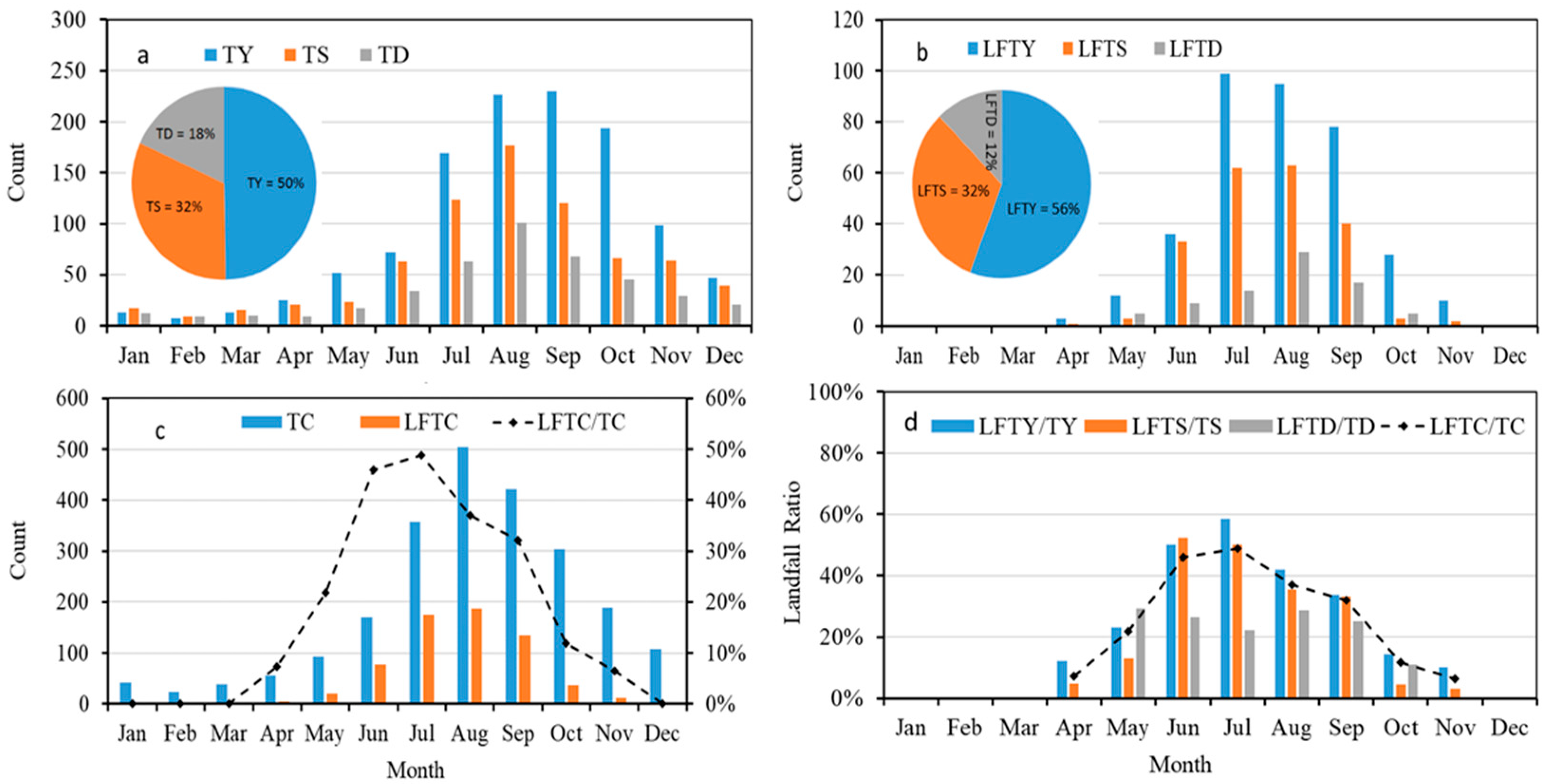
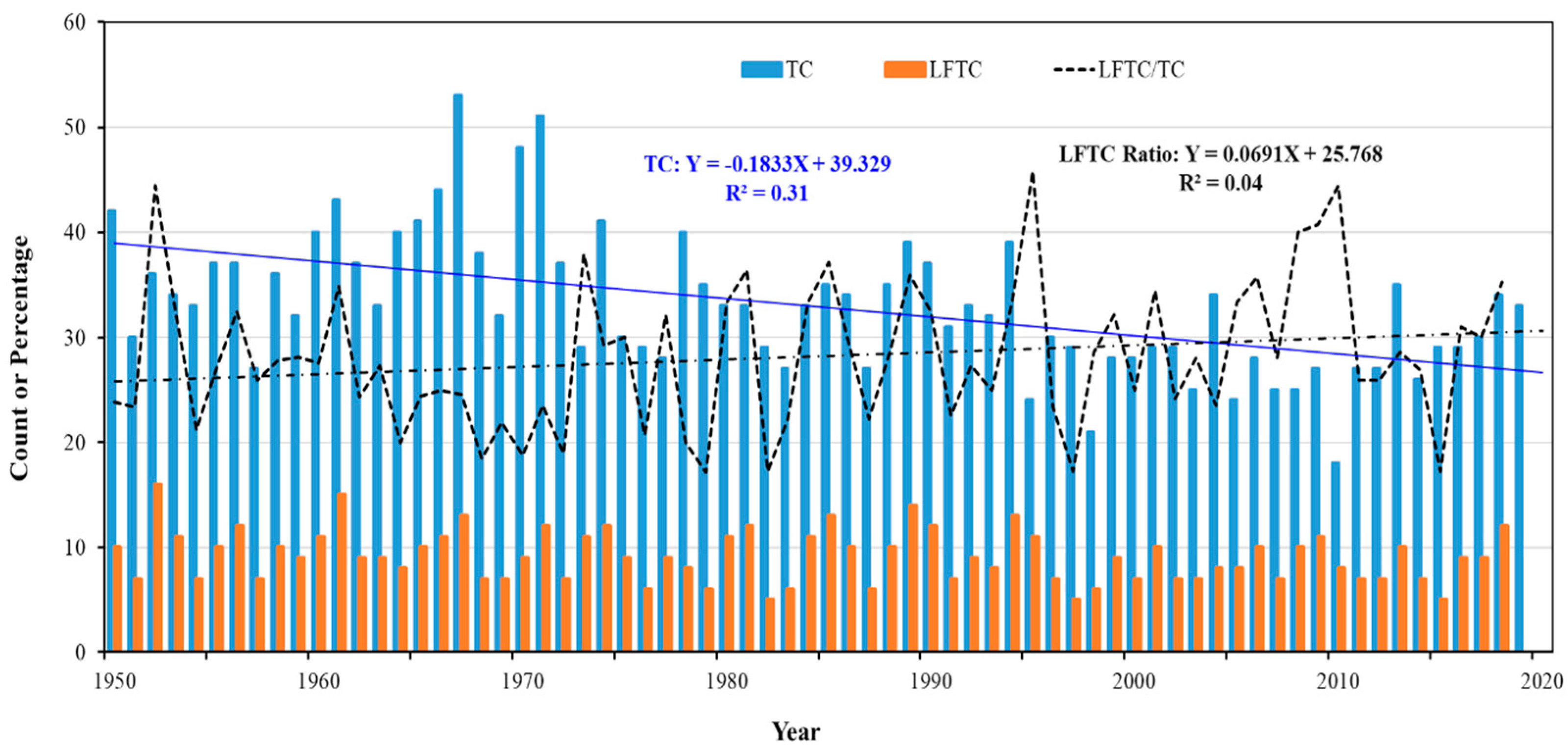
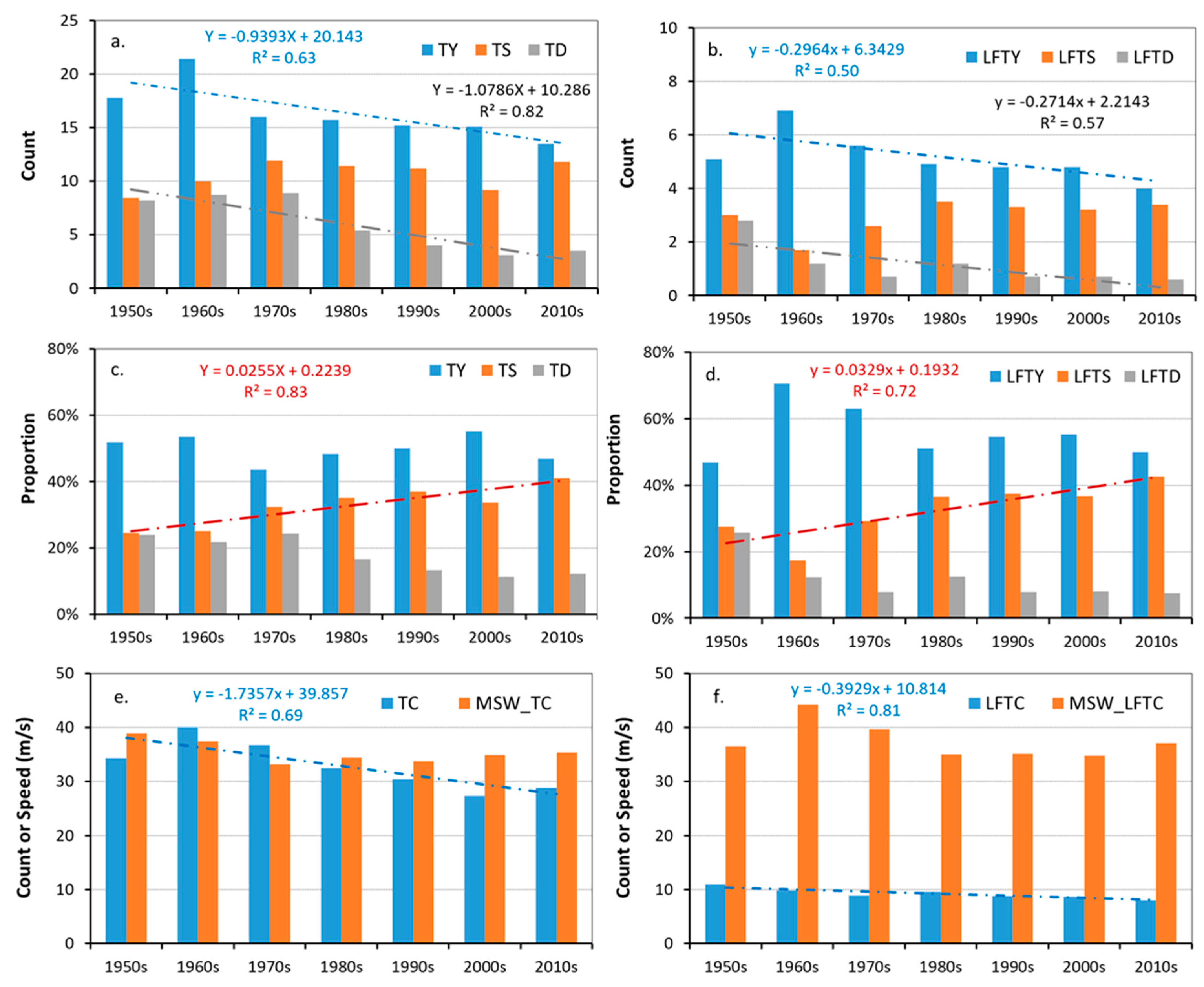
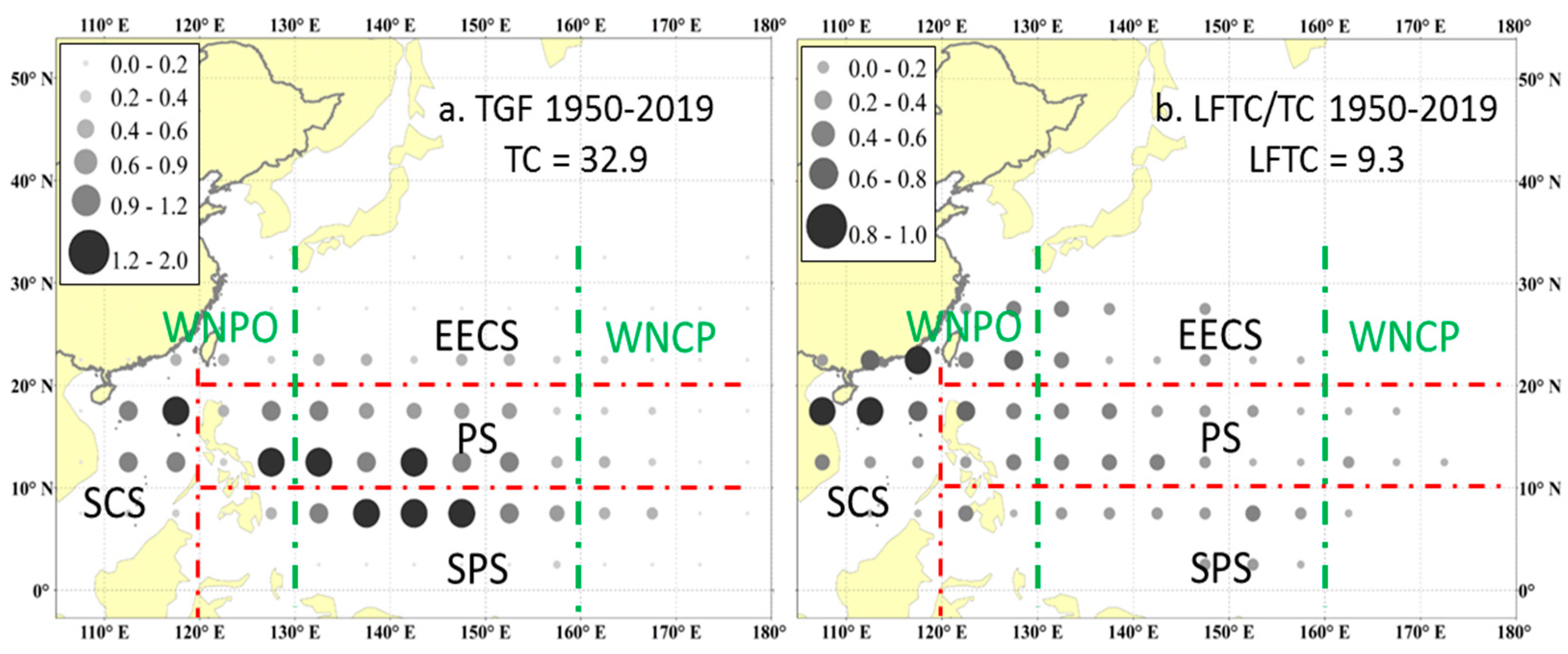
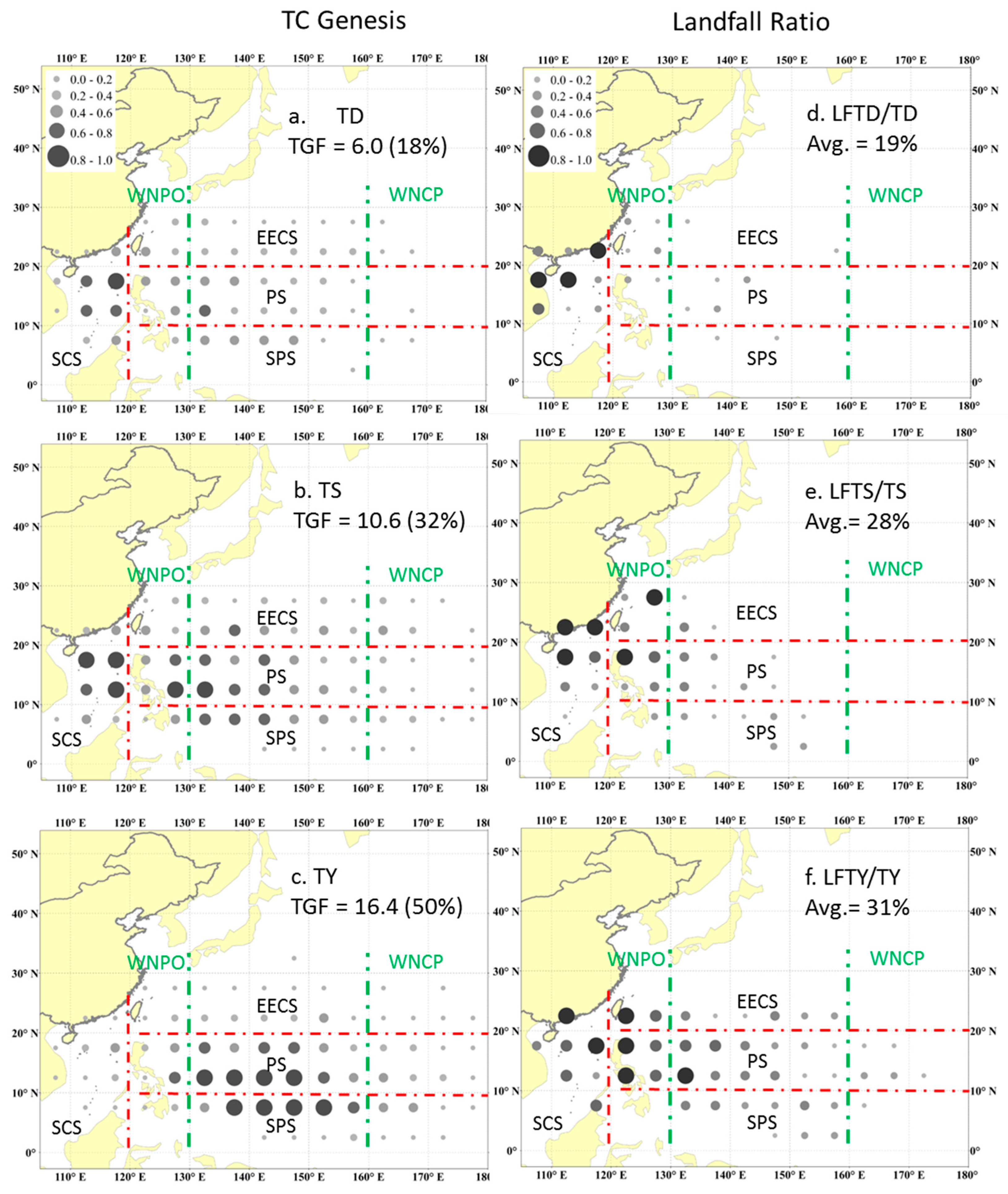
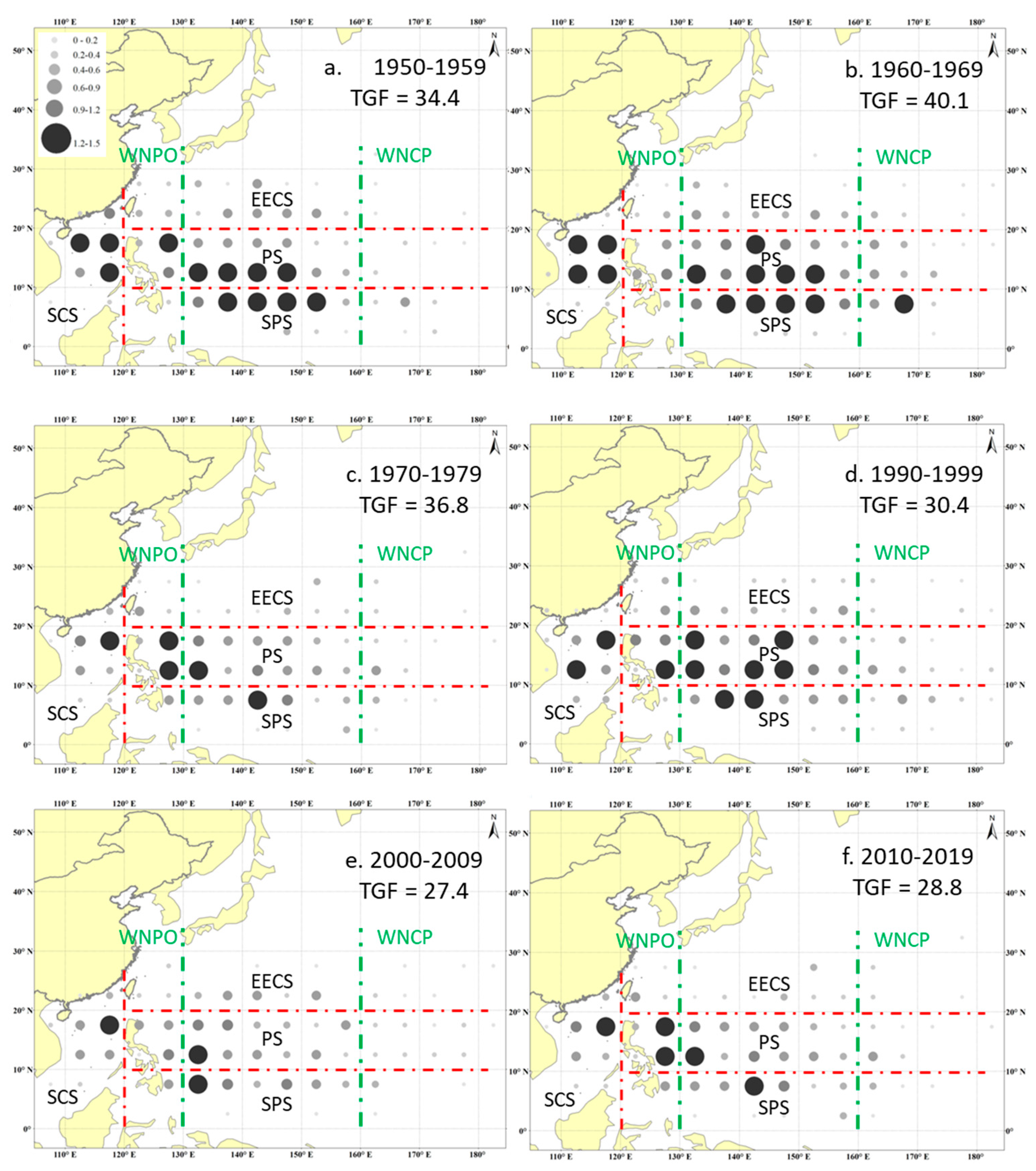


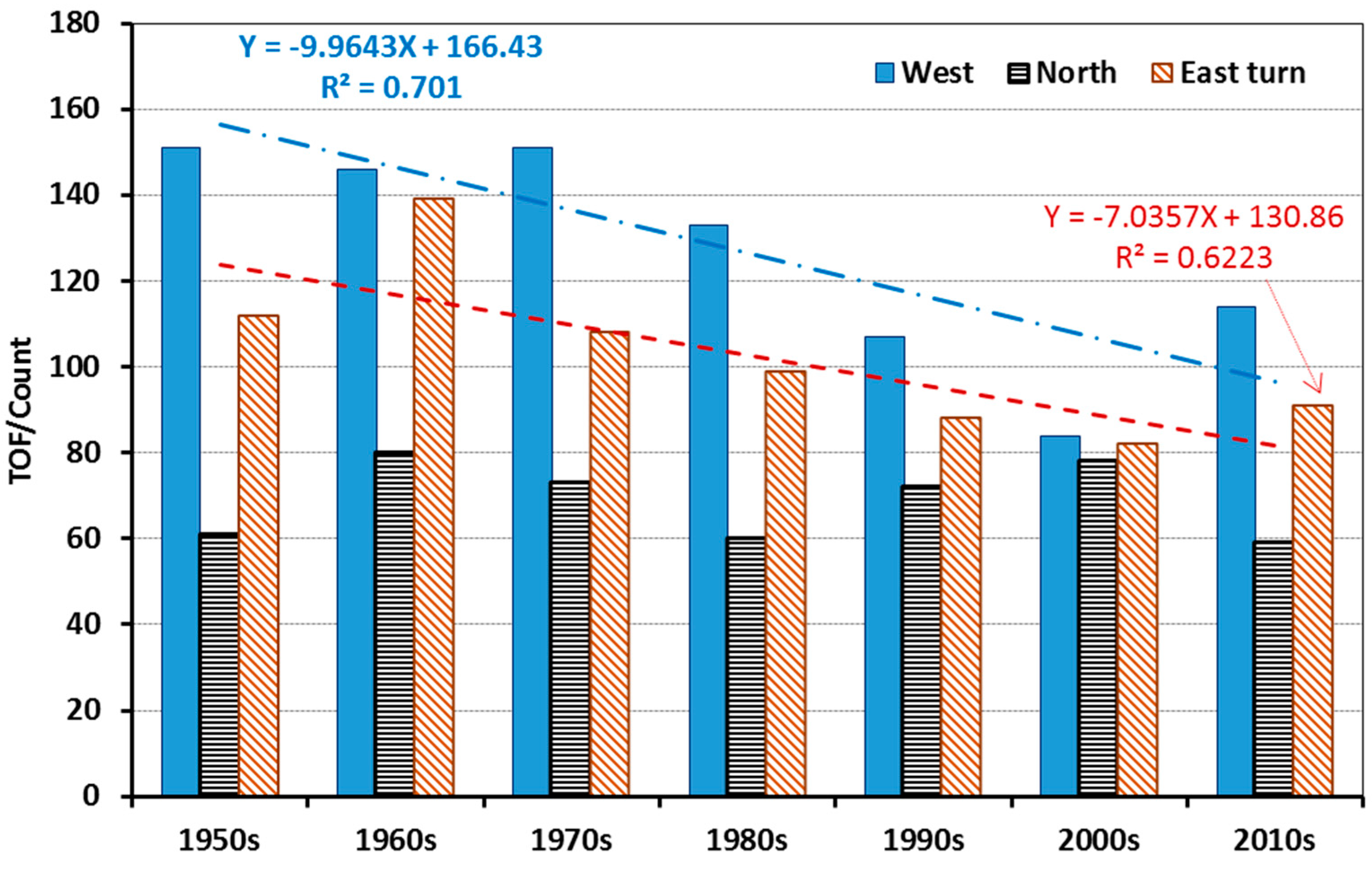

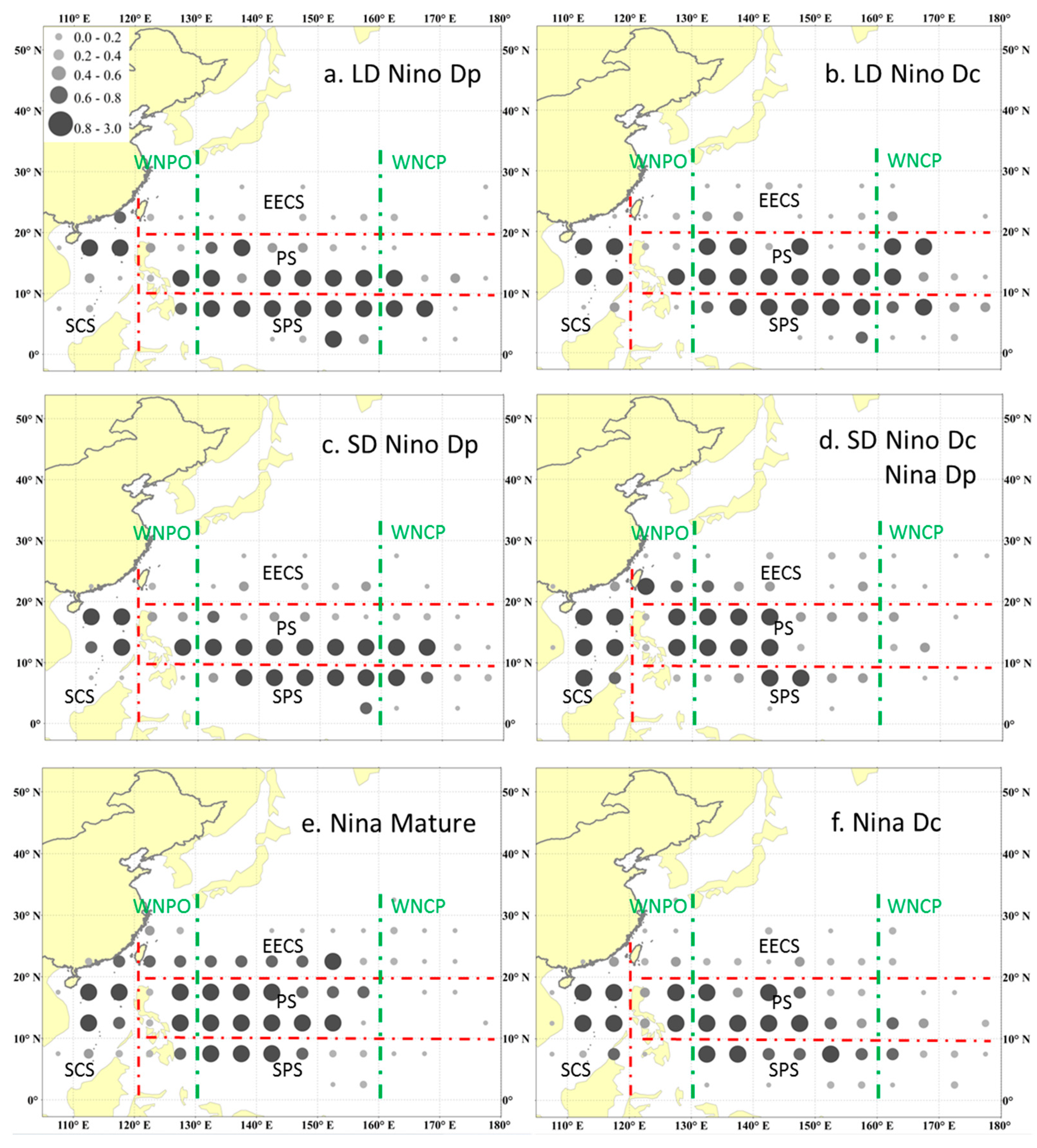
| Years | SCS | SPS | PS | EECS | WNPO | WNCP | WNP | MSW m/s |
|---|---|---|---|---|---|---|---|---|
| 1950s | 7.0 | 10.2 | 12.1 | 5.1 | 3.9 | 2.1 | 34.4 | 38.9 |
| 1960s | 7.3 | 12.7 | 15.8 | 4.3 | 3.2 | 5.2 | 40.1 | 37.5 |
| 1970s | 6.0 | 8.7 | 16.2 | 5.9 | 4.3 | 3.8 | 36.8 | 33.2 |
| 1980s | 5.2 | 8.9 | 13.1 | 5.3 | 4.5 | 2.7 | 32.5 | 34.4 |
| 1990s | 5.7 | 6.3 | 14.8 | 3.6 | 4.6 | 3.5 | 30.4 | 33.7 |
| 2000s | 4.7 | 6.8 | 12.2 | 3.7 | 4.0 | 2.5 | 27.4 | 34.9 |
| 2010s | 4.6 | 6.9 | 14.0 | 3.3 | 5.2 | 2.8 | 28.8 | 35.3 |
| 1950–2019 | 18% | 26% | 43% | 14% | 13% | 10% | 32.9 | 35.4 |
| Area proportion | 12% | 27% | 26% | 36% | 13% | 30% | 100% | n.a. |
| Change rates | −37% | −46% | −11% | −23% | 63% | −46% | −28% | −5.7% |
| Years | SCS | SPS | PS | EECS | WNPO | WNCP | WNP | MSW m/s |
|---|---|---|---|---|---|---|---|---|
| 1950s | 3.9 | 2.9 | 2.9 | 0.6 | 1.3 | 0.1 | 10.3 | 36.5 |
| 1960s | 2.6 | 2.6 | 4 | 1 | 1 | 0.3 | 10.2 | 44.2 |
| 1970s | 2.1 | 1.3 | 5.1 | 0.6 | 1.5 | 0 | 9.1 | 39.7 |
| 1980s | 2.5 | 2 | 3.9 | 1.2 | 1.7 | 0.2 | 9.6 | 35.0 |
| 1990s | 2.8 | 1.2 | 4.4 | 0.6 | 2.2 | 0 | 9.0 | 35.1 |
| 2000s | 2.3 | 1.3 | 4.3 | 0.9 | 2.4 | 0.2 | 8.8 | 34.8 |
| 2010s | 2.1 | 0.7 | 4.3 | 1 | 2.7 | 0.2 | 8.1 | 37.1 |
| 1950–2019 | 28% | 18% | 44% | 9% | 20% | 2% | 9.3 | 37.5 |
| Area proportion | 12% | 27% | 26% | 36% | 13% | 30% | 100% | n.a. |
| Change rates | −19% | 0% | 8% | −73% | 170% | −33% | −21% | −16.1% |
| Years | SCS | SPS | PS | EECS | WNPO | WNCP | WNP |
|---|---|---|---|---|---|---|---|
| 1950s | 184 | 95 | 300 | 377 | 218 | 60 | 955 |
| 1960s | 228 | 110 | 415 | 503 | 258 | 99 | 1257 |
| 1970s | 248 | 84 | 326 | 410 | 249 | 81 | 1068 |
| 1980s | 205 | 74 | 314 | 348 | 214 | 60 | 942 |
| 1990s | 178 | 60 | 293 | 339 | 195 | 70 | 869 |
| 2000s | 158 | 50 | 252 | 337 | 199 | 51 | 796 |
| 2010s | 184 | 63 | 265 | 349 | 229 | 57 | 860 |
| 1950–2019 | 21% | 8% | 32% | 39% | 23% | 7% | 964 |
| Area proportion | 12% | 20% | 19% | 49% | 13% | 29% | 100% |
| Change rates | −31% | −55% | −39% | −33% | −23% | −48% | −37% |
| West Tracks | 36% | 10% | 35% | 19% | 27% | 4% | 324 |
| North Tracks | 11% | 6% | 31% | 52% | 25% | 8% | 202 |
| West–East Turn | 11% | 8% | 34% | 48% | 20% | 9% | 353 |
| West Tracks | North Tracks | West-East Turn Tracks | |
|---|---|---|---|
| TC Genesis | 886 | 483 | 719 |
| Genesis proportion | 38% | 21% | 31% |
| Genesis date mode | 60% (July–September) | 65% (July–September) | 56% (August–October) |
| TY | 42% | 51% | 66% |
| TS | 35% | 32% | 26% |
| TD | 23% | 17% | 8% |
| Landfall ratio | 46% | 27% | 11% |
| Items | ENSO Phase | Years | ENSO Index | * ENSO Months | * Total Months | All TCs | Landfall TCs | LFTC/TC |
|---|---|---|---|---|---|---|---|---|
| SD El Niño | El Niño Developing | 6 | 1.65 | 9.8 | 14.0 | #30.7 | 6.2 | 20.0% |
| El Niño Decaying & La Niña Developing | 6 | −0.88 | 6.0 | 14.0 | 32.2 | 8.8 | 27.4% | |
| LD El Niño | El Niño Developing | 6 | 0.83 | 6.2 | 16.8 | 32.0 | 7.2 | 22.5% |
| El Niño Decaying | 6 | 0.78 | 9.0 | 16.8 | 33.5 | 8.0 | 23.5% | |
| La Niña | La Niña Developing | 8 | −0.97 | 7.6 | 23.5 | 31.1 | 9.0 | 30.5% |
| La Niña Mature | 8 | −0.62 | 10.0 | 23.5 | 35.4 | 10.6 | 30.5% | |
| La Niña Decaying | 8 | 0.11 | 4.1 | 23.5 | 31.6 | 9.1 | 28.9% | |
| Neutral Years | 22 | −0.03 | n/a | n/a | 33.2 | 9.8 | 29.4% | |
Disclaimer/Publisher’s Note: The statements, opinions and data contained in all publications are solely those of the individual author(s) and contributor(s) and not of MDPI and/or the editor(s). MDPI and/or the editor(s) disclaim responsibility for any injury to people or property resulting from any ideas, methods, instructions or products referred to in the content. |
© 2023 by the authors. Licensee MDPI, Basel, Switzerland. This article is an open access article distributed under the terms and conditions of the Creative Commons Attribution (CC BY) license (https://creativecommons.org/licenses/by/4.0/).
Share and Cite
Yu, Q.; Wang, X.; Fang, Y.; Ning, Y.; Yuan, P.; Xi, B.; Wang, R. Comprehensive Investigation on Spatiotemporal Variations of Tropical Cyclone Activities in the Western North Pacific, 1950–2019. J. Mar. Sci. Eng. 2023, 11, 946. https://doi.org/10.3390/jmse11050946
Yu Q, Wang X, Fang Y, Ning Y, Yuan P, Xi B, Wang R. Comprehensive Investigation on Spatiotemporal Variations of Tropical Cyclone Activities in the Western North Pacific, 1950–2019. Journal of Marine Science and Engineering. 2023; 11(5):946. https://doi.org/10.3390/jmse11050946
Chicago/Turabian StyleYu, Qi, Xianwei Wang, Yongjun Fang, Yazhou Ning, Peiqing Yuan, Bingrou Xi, and Runzhi Wang. 2023. "Comprehensive Investigation on Spatiotemporal Variations of Tropical Cyclone Activities in the Western North Pacific, 1950–2019" Journal of Marine Science and Engineering 11, no. 5: 946. https://doi.org/10.3390/jmse11050946
APA StyleYu, Q., Wang, X., Fang, Y., Ning, Y., Yuan, P., Xi, B., & Wang, R. (2023). Comprehensive Investigation on Spatiotemporal Variations of Tropical Cyclone Activities in the Western North Pacific, 1950–2019. Journal of Marine Science and Engineering, 11(5), 946. https://doi.org/10.3390/jmse11050946







